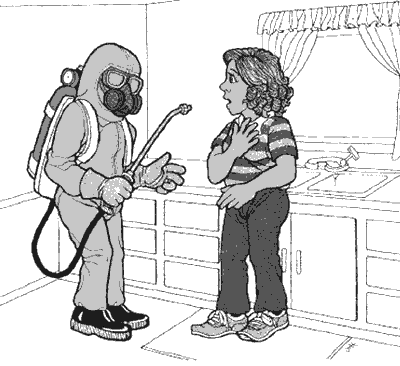There are safe alternatives to the massive use of toxic pesticides in our homes for pest control, which in addition to helping protect the health of your home and your family will keep insects, rodents and other unwanted creatures away from our homes.
Eliminating these pests with powerful poisons may seem like the simplest and most satisfactory solution, but what we often fail to consider is that what is toxic to household pests is also often toxic to people, especially children.
- Many insects and rodents are attracted to food and water, so start by making your home less tempting to pests.
- Clean up spills immediately with soap and water.
- Take out the trash daily and keep trash cans free of food residue.
- Keep ripe fruit in the refrigerator.
- Wash dishes daily, or at least soak them in soapy water until you can wash them.
- Make sure all food and drink containers and packaging outside the refrigerator or freezer are tightly sealed or closed. Glass jars with rubber seals or plastic containers with snap-on lids are better than those with screw-on lids.
- Sweep or vacuum floors regularly.
- Keep bathroom and kitchen areas as dry as possible. Fix any water leaks and do not allow water to accumulate.
- If you have a pet, brush it often with a flea comb and wash its bedding frequently. Be sure to vacuum floors, carpets and couches that your pet comes into contact with regularly. (Make sure to vacuum the floor, carpet and couches that your pet comes into contact with regularly.) Click here for more information on pesticides and pets.)
- Deny access to new invaders by ensuring potential entry points are sealed.
- Use silicone to seal cracks and gaps in floorboards, frames, shelves, pipes, ducts, dishwashers, toilets and outlets.
- Put screens in front of the hot and cold air duct outlets, and repair holes in all existing screens. The average house mouse can squeeze through a hole the size of a dime.
- Keep vegetation, fireplace wood, and other debris away from the outside of your home so pests can't climb inside.
Now that you've denied pests food, shelter, and access, it's time to get rid of the intruders left inside. To solve your pest problem without using chemical pesticides, you can:
- Use the vacuum machine to suck up insects and their nests (insects will usually suffocate in the bag).
- Set traps (pheromone, jar, flight, lux, etc.).
- Use a fly swatter.
If the problem persists, try these techniques, which will minimize health risks to members of your household:
- Pour boric acid into cracks and crevices, which slowly poisons non-flying insects like ants and cockroaches, but is much less toxic to humans and other mammals. (Still, you should avoid pouring it in areas that may result in human exposure.) Visitwww.beyondpesticides.org for more details.
- To control insects and rodents, try heavy-duty bait boxes — an effective and safer option than aerosol sprays, dusts, or small pellets, which spread pesticide residues. Look for one that uses a nonvolatile chemical, such as boric acid, and be sure to keep bait stations out of reach of children. Visit www.beyondpesticides.org for more details.
- Try insecticidal or fatty acid soap, which kills soft-bodied insects such as caterpillars, fleas, and termites on contact, and is virtually harmless to humans and mammals unless ingested. www.beyondpesticides.org for more details.
- Hire a professional trained in Integrated Pest Management (IPM), who uses physical controls and low-toxicity products to manage pest problems.
STEP 5. Minimize exposure
- When using any pesticide, be sure to limit exposure to all members of your household.
- Avoid frequent preventive applications. Never exceed the application rates indicated in the instructions.
- When applying pesticides, follow all precautions listed on the label, such as wearing gloves, masks, and protective glasses.
- Make sure all residue from traps, bait stations, and pesticides are out of reach of children and pets.
- Never dispose of pesticide residues in the trash, yard, or down sinks, where they can contaminate soil or drinking water. Check with your utility department to determine how to dispose of hazardous waste.
Nontoxic pest controls work very well outside the home. We may be able to control weeds, plant diseases, and garden insects without having to use dangerous chemicals. For example, cutting grass at a high height (recommendations vary depending on the grass species) helps prevent weeds from taking hold.
In pastures and gardens, make sure you are growing species that are well adapted to local soil conditions. And good weeding, hoeing and hand pruning, as well as the use of slow-release organic fertilizers, are effective in controlling weeds, insects, and diseases.
If you choose to use pesticides, opt for spot treatment. Extensive use, including perimeter spraying, can create contaminated runoff and end up in waterways. For detailed information on how to control everything from aphids to dandelions to powdery mildew, read the excellent data sheets from the Northwest Coalition for Pesticide Alternatives.
The pesticide database The Pesticide Action Network of North America offers information on less toxic and nontoxic alternatives.
The University of California site on integrated pest management provides data sheets for managing individual pests.
Beyond Pesticides, a nonprofit organization that provides a national searchable database of the least toxic pest management companies on its website.
![]()


